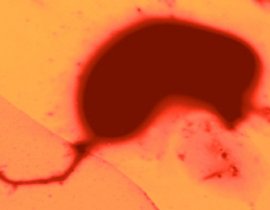|
Microbiologists have found an ecosystem
of extreme-loving microbes working together to survive at the bottom
of California's strange Mono Lake.
by Ron Koczor
Humans don't like being alone. So when
Richard Hoover, a microbiologist at the NASA Marshall Space Flight
Center, travels, he looks to see where the locals hang out. Not
in hotels, though, or in restaurants or nightclubs. The places he
looks are more exotic: Deep mines under the permafrost of Alaska
and Siberia, the high mountains of Antarctica, and the salty, alkaline
bottom of California's Mono Lake.
And what does he find?
Life. In abundance.
Richard Hoover is an
extremophile hunter. He searches the most inhospitable places for
lifeforms that love extremes: scalding heat, freezing cold, salt,
lye, darkness. And like other researchers exploring the limits of
life on our planet, he's found a surprising variety of species ranging
from simple bacteria to plants and animals.
He also finds that
species of extremophiles depend on each other to make a living-much
like ordinary lifeforms do.
"The diversity of
life on Earth boggles the mind," marvels Hoover. There are hundreds
of thousands of green plant species. Green algae alone comes in
thousands of different varieties, he says. There are millions of
species of animals. More than 6,000 species of bacteria and 3,600
viruses have been named. Researchers suspect there are more than
a million species of fungus, although only 70,000 or so have been
identified.
Few (and perhaps none)
of these species live in splendid isolation. They depend on others.
Plants use sunlight, carbon dioxide, and minerals to create organic
compounds (sugars, proteins, fats, etc.). Animals take these compounds
for their own needs. When animals die, they return to minerals and
carbon dioxide and the cycle renews.
Cooperation between
species is common. For example, the tropical African Gray Parrot
eats fruit from trees. For reasons no one understands, these birds
sling bits of fruit containing seeds far from the tree. This helps
the trees spread their seeds and reproduce. Many instances are well
documented of other animals helping spread plants through their
droppings. At the complex plant/animal level in a biologically rich
environment, interdependence of species seems to be conducive to
life.

A false colour photomicrograph of the new extreme-loving
microbe, Desulfonatronum thiodismutans, recently
discovered in Mono Lake by Richard Hoover and colleagues.
Note the flagellum (lower left), which it uses for movement.
|
But what about simpler
lifeforms found in extreme environments? Do they too exhibit such
interdependent life styles? NASA is interested because the agency
is tasked to explore for life in the Universe. Many scientists expect
the first signs of life confirmed off Earth - on Mars, within comets,
or in the suspected oceans of Europa - will be unicellular lifeforms
such as bacteria, archaea, or diatoms rather than complex technological
species. Understanding how these species live in extreme conditions
is vital to NASA's mission.
Hoover and microbiologist
Elena Pikuta of the University of Alabama in Huntsville are working
to answer some of these questions by studying lifeforms in California's
Mono Lake. They recently announced the discovery of a third new
species of bacteria, Desulfonatronum thiodismutans, living
in the lake in the International Journal of Systematic and Evolutionary
Microbiology. All three of Pikuta and Hoover's new species are extremophiles.
The bacteria thrive in the dark mud of Mono Lake, devoid of oxygen
with 3 times higher salinity than sea water and alkalinity that
approaches lye.
This third new species
is particularly interesting because of its niche in the extreme
ecology of the lake. This bacterium obtains its energy from sulfur
and other inorganic compounds. It does not require sunlight or other
organic materials to thrive and is a type of organism known as a
chemolithotroph. Hoover and Pikuta's two previous new species, Tindallia
californiensis and Spirochaeta americana are also
extremophiles from Mono Lake, but ingest organic materials. These
organisms are known as organotrophs. Together they paint a picture
of interlinked and interdependent life, even under extreme conditions.

Richard Hoover collects samples from the mud of Mono Lake.
|
For example, D.
thiodismutans gets its energy from hydrogen and sulfur compounds
in the minerals of the lake mud. From these it creates sugars and
other organic materials. T. californiensis can consume
simple amino acids and other chemicals and also produces complex
organic compounds such as sugars, fats, proteins, etc. S. americana
ingests the complex organic compounds and excretes hydrogen and
other gases. When it dies, it returns to minerals and the cycle
is complete.
Unlike the plant/animal
cycle in our "normal" environment, this bacterial cycle does not
necessarily need visible energy from sunlight to drive photosynthesis.
It can be driven completely by the chemical energy of the reactions.
So in a dark, extreme environment, life appears to develop the same
interdependent strands, with different species finding the niche
that allows each to thrive.
One day, perhaps, lifeforms
like these will be found on other worlds. The work of Hoover and
Pikuta is telling us that if we find one species, we should look
for more. Extremophiles, like "ordinary" lifeforms, don't like being
alone.
|
